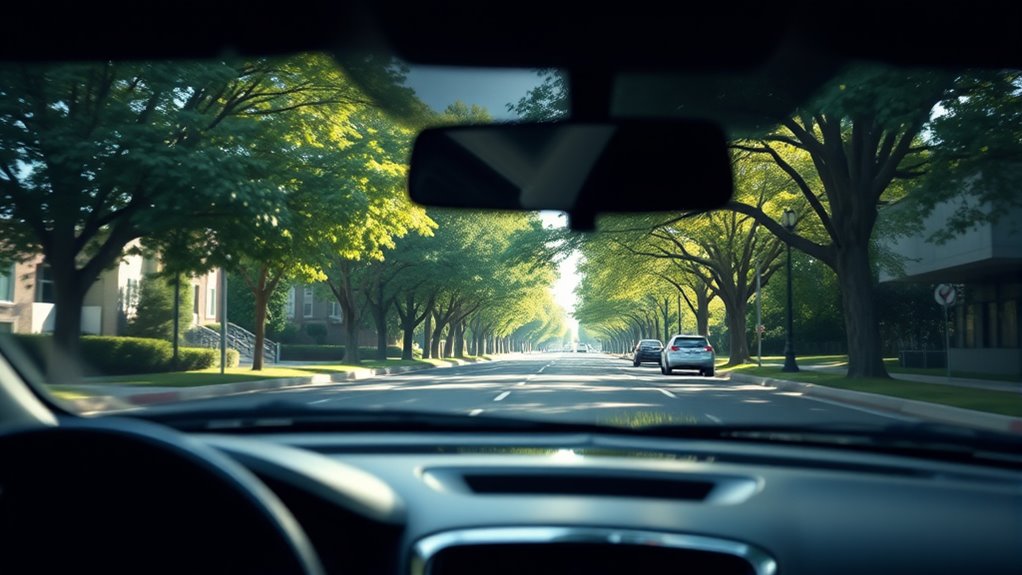When you’re stuck in traffic, you can practice quick micro-meditations to stay calm and focused. Try focused breathing at stoplights, inhaling deeply and exhaling slowly to reset your mood. Do a brief body scan, noticing tension and relaxing muscles. Observe your surroundings or listen to sounds without judgment, or repeat a calming mantra silently. Visualize a peaceful scene or focus on your breath cycles to cultivate patience. Keep exploring these simple techniques to make your commute more peaceful.
Key Takeaways
- Practice focused breathing at stoplights to calm your mind and manage frustration during traffic delays.
- Perform body scans to release tension, enhancing relaxation while waiting in traffic jams.
- Use sensory observation by noticing sounds, textures, and visual details to stay present and centered.
- Count breath cycles or notice silent moments to cultivate calmness and reduce stress during traffic congestion.
- Engage in mindful observation of surroundings, such as vehicle details and traffic signals, to foster patience and appreciation.
Focused Breathing During Stoplights

When you’re stopped at a red light, it’s the perfect moment to practice focused breathing. As traffic flow slows or halts, your car features—like the steering wheel and dashboard—become anchors for awareness. Take a deep breath in, feeling the rise of your chest, then exhale slowly. Pay attention to the rhythm of your breath, letting it match the subtle movements of the traffic around you. The quiet pause helps clear your mind amid the noise of honking horns and engine sounds. Concentrating on your breath keeps you present, preventing frustration from the stop-and-go traffic. Recognizing the importance of emotional regulation can help you manage feelings of irritation more effectively. This simple practice transforms a mundane moment into a brief meditation, helping you stay calm and centered until the lights turn green again.
Body Scan While Waiting in Traffic

As you sit in traffic, it’s a perfect opportunity to tune into your body with a quick scan. Notice how your muscles feel, from your shoulders to your legs. Focus on areas of tension or relaxation, letting go of any tightness. The engine hum and traffic jam create background noise, but now you’re attentive to your physical state. Use this table as a guide:
| Body Part | Sensation | Relaxation Tip |
|---|---|---|
| Shoulders | Tension or looseness | Roll or shrug gently |
| Neck | Tightness or comfort | Gently stretch or relax |
| Hands | Fidgeting or stillness | Rest them on your lap |
| Legs | Restless or calm | Shift or stay still |
| Feet | Tingling or grounded | Wiggle toes or relax |
This quick body scan helps reset your focus amid the traffic jam. Incorporating mindful awareness techniques can further enhance your relaxation during such moments as part of mindful breathing practices.
Mindful Observation of Surroundings

Instead of letting your mind wander during a traffic jam, take a moment to observe your surroundings with full awareness. Notice the traffic etiquette of other drivers—when they yield, signal, or maintain safe distances. Observe how vehicles are maintained—are they clean, well-kept, or showing signs of wear? Pay attention to the variety of cars, noting details like bumper stickers or license plates. This mindful observation keeps you present and engaged, reducing frustration. It also cultivates patience and appreciation for the diversity of drivers and vehicles around you. As you focus on these details, your mind shifts from impatience to curiosity. This simple practice helps you stay calm, alert, and respectful, transforming a stressful wait into a moment of mindful connection. Recognizing the high water content of many vegetables can also inspire you to incorporate more vegetable juices into your diet for added hydration and health benefits.
Counting Breath Cycles for Calmness

In the midst of a traffic jam, focusing on counting your breath cycles can bring immediate calmness. To do this, breathe in slowly through your nose, then exhale smoothly through your mouth or nose. Count each full inhale and exhale as one breath cycle. As you do this, silently repeat mental affirmations like “I am calm” or “This moment is temporary.” Concentrating on counting breath cycles redirects your attention from frustration to your breath, grounding you in the present. Keep your focus gentle and steady, avoiding force or speed. This simple practice calms your nervous system, reducing stress and anxiety. With each breath cycle, you build a sense of control and tranquility, transforming a tense situation into a moment of mindful peace. Using techniques like deep breathing can further enhance the soothing effect during stressful moments.
Progressive Muscle Relaxation on the Go

When you’re stuck in traffic and can’t sit comfortably, practicing progressive muscle relaxation can help ease tension. This technique involves tensing and then relaxing specific muscle groups, which reduces muscle tension and promotes relaxation. You can do this quietly while keeping your eyes on the road or dashboard. Start with your hands, squeezing them into fists, then releasing. Move up to your shoulders, tensing them briefly before letting go. Focus on the sensation of relaxation, not just the tension. Incorporating deep breathing techniques can further enhance the calming effects of this practice. This simple relaxation technique helps break the cycle of stress and physical tightness that traffic often causes. With consistent practice, you’ll find it easier to relax your body even during stressful commutes, turning traffic time into a moment of calm and mindfulness.
Repeating a Positive Mantra

Practicing progressive muscle relaxation helps release physical tension, but mental calm can be reinforced by repeating a positive mantra. When you choose a calming affirmation, such as “I am in control” or “I am calm,” you strengthen your mental resilience through repetition. This act of affirmations reinforcement shifts your focus away from frustration or stress, grounding you in a moment of peace. This process can also help mitigate security vulnerabilities in your mental practices, just as businesses address potential cybersecurity threats. Keep your eyes on the road, and quietly repeat your mantra in your mind. The constant mental repetition helps quiet racing thoughts and cultivates a sense of stability amid traffic chaos. Over time, this simple practice can become a powerful tool to maintain calmness, transforming your commute into an opportunity for mindfulness and self-affirmation.
Visualizing a Peaceful Place

Close your eyes and picture a peaceful place where you feel safe and relaxed. Notice the sensory details—what you see, hear, and smell—that make this space calming. Focusing on these details helps bring a sense of tranquility even amid traffic. If you have a electric bike, you might imagine yourself riding smoothly through this serene environment, feeling the instant torque and lightweight comfort that makes the journey more enjoyable.
Envision Calm Surroundings
If traffic noise starts to overwhelm you, take a moment to picture a tranquil place in your mind. Imagine yourself in a peaceful spot, maybe a quiet beach or a lush forest. As you do, focus on creating a sense of calm that surrounds you, much like practicing mindful eating helps you appreciate each bite. Use gratitude journaling to remind yourself of the peaceful moments outside traffic chaos. Visualize yourself breathing slowly and feeling grounded in this serene environment. Let this mental image serve as a calming anchor, helping you detach from the noise and stress. A mindful approach to asset division can help reduce overall stress during challenging times. This simple exercise allows you to carry a sense of calm with you, turning a stressful commute into an opportunity for mental peace.
Focus on Sensory Details
Imagine yourself in a peaceful place, engaging all your senses to deepen the experience. Focus on sound symbolism—notice the gentle hum of nature or distant bird calls, which can evoke calmness. Pay attention to how your senses adapt; initially, sounds might seem loud, but with sensory adaptation, they fade into the background, helping you relax. To enhance this practice:
- Visualize vivid details, like lush greenery or calm water.
- Listen for subtle sounds, such as rustling leaves or flowing streams.
- Feel the textures around you, like soft grass or cool water.
- Incorporate the use of sensory details to enrich your visualization and deepen relaxation.
Noticing Sensations and Sounds

As you sit in traffic, pay attention to how your body feels—your hands gripping the wheel or your shoulders relaxing. Listen closely to the sounds around you, from engine hums to distant conversations, noticing each one without judgment. Don’t forget to notice those quiet moments when sounds fade, giving you a brief chance to pause and breathe. Practicing tuning techniques can help you become more aware of these sensations and sounds, enhancing your mindfulness during your commute.
Tuning Into Physical Feelings
Tuning into physical feelings while stuck in traffic involves paying close attention to the sensations and sounds around you. Focus on your body’s signals, noticing areas of tension or relaxation. This practice enhances emotional awareness and helps you stay present.
Here are three ways to deepen this awareness:
- Observe your breathing, noticing how your chest rises and falls—similar to mindful eating, where attention to sensations creates calm.
- Scan your body for tension, then consciously relax those areas to reduce stress.
- Pay attention to subtle sounds or sensations, anchoring your mind in the present moment.
Listening to Surroundings
Listening to your surroundings while in traffic involves actively tuning into the subtle sounds and sensations around you. Focus on the traffic flow, noticing how it shifts and varies, creating a rhythmic backdrop. Pay attention to vehicle sounds—the hum of engines, the honking of horns, or the squeal of brakes—without judgment or reaction. Let these noises serve as anchors to the present moment, grounding your awareness. Feel the vibrations from the road beneath your vehicle and the ambient sounds blending into a continuous symphony. Rather than filtering them out, embrace these sensations as part of your environment. This practice sharpens your mindfulness, helping you stay calm and centered amid the busyness of traffic.
Noticing Silent Moments
Have you ever noticed the quiet moments that emerge amid the constant hum of traffic? These silent pauses offer a chance to deepen your awareness. To embrace them, try this:
- Tune into your body sensations—feel the seat beneath you, the breeze on your skin.
- Listen for subtle sounds—your breathing, distant sirens, or the faint hum of engines.
- Practice gratitude journaling by noting small moments of calm or clarity during your commute.
Just like mindful eating helps you savor each bite, noticing silent moments encourages appreciation for stillness. These pauses can bring clarity and calm, making traffic time a mindful retreat rather than a hassle. Recognizing these quiet instances nurtures gratitude and presence in everyday life.
Frequently Asked Questions
How Long Should Each Micro-Meditation Session Last During Traffic?
When considering session length for micro-meditations, it’s best to keep them brief and manageable. Duration guidelines suggest 1 to 3 minutes per session, making it easy to fit into your busy schedule. During traffic, you might aim for about 2 minutes, focusing on deep breaths or mindful awareness. This way, you stay relaxed without distracting yourself from driving, ensuring safe and effective use of your time.
Can Beginners Easily Practice These Meditations Without Prior Experience?
Ever wondered if meditation for newcomers can be simple enough for anyone? Absolutely! These beginner-friendly practices are designed for easy, quick integration into your daily routine. You don’t need prior experience—just a willingness to try. Micro-meditations in traffic are accessible and effective, helping you stay calm and focused. With consistent practice, you’ll find them becoming a natural part of your day, even during busy commutes.
Are There Any Safety Considerations to Keep in Mind While Meditating in Traffic?
When practicing micro-meditations in traffic, you should prioritize road safety and driver awareness. Keep your focus on the road, avoid closing your eyes or anything that distracts you. Use subtle breathing exercises that don’t take your attention away from driving. Always stay alert to your surroundings, and only meditate if it’s safe and appropriate. Your safety and the safety of others come first, so practice mindfulness responsibly.
How Can I Stay Focused if I Get Distracted Easily?
Imagine your mind is a busy highway; distractions are like sudden detours. To stay focused, use mindfulness techniques like deep breathing or gentle awareness of your surroundings. Practice distraction management by gently guiding your attention back whenever it wanders. Just like steering through traffic safely, staying centered requires patience and practice. Keep your focus steady, and you’ll find a peaceful flow even amid life’s chaos.
Is It Effective to Combine Multiple Techniques for Better Relaxation?
Combining multiple techniques for relaxation enhancement can be highly effective, as it allows you to address different stress aspects simultaneously. Technique integration helps you customize your approach, making relaxation more accessible and powerful. You might blend deep breathing with visualization or progressive muscle relaxation. This variety keeps your practice engaging and enhances overall calmness, so you’re better equipped to manage stress and stay focused even when distractions arise.
Conclusion
Next time you’re stuck in traffic, remember these micro-meditations to turn frustration into calm. With just a few mindful breaths or a gentle scan of your surroundings, you can transform a traffic jam into a moment of peace—like finding an oasis in the chaos. These tiny practices are your secret weapon against stress, turning gridlock into a gateway to serenity. So, take a deep breath and let tranquility take over, no matter how long the wait.










